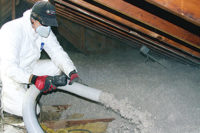
Heat Pumps
On the geothermal front,ClimateMaster(www.climatemaster.com) introduced the first water-source unit designed from the ground up for R-410A, the company said. The Tranquility offers EERs in the range of 27 to 31 and utilizes a Copeland Ultra-Techâ„¢ scroll compressor. This unit offers a 40-percent efficiency increase in part-load mode, and the variable-speed ICM2 blower motor adjusts to multiple duct system applications and provides soft start for added comfort and quiet operation, the company said.Spokesman Van Bourn said that the Tranquility was designed with the service technician in mind. "The unit has five panels for better access, and everything can be serviced from the front," said Bourn. Standard features include a 2-inch filter rack with a MERV 11 pleated air filter, foil-faced insulation in the blower section, a fully insulated compressor section, an E-coated air coil, and the Unit
Protection Sentinel (U.P.S.), which is designed to inform homeowners of poor performance before the system locks out. The unit comes with a 10-year limited warranty on all major refrigerant circuit components.
Marvair (www.marvair.com) introduced its GeoScholar II geothermal heat pump, which is designed to be installed inside a classroom.
The GeoScholar II water-source heat pump is currently available in a capacity of 3.5 tons, but products ranging from 2 to 5 tons should be available by mid-year.
The GeoScholar II heat pump is a water-source version of the company's popular air-source unit. It features quiet operation and extremely high efficiencies of 16.2 EER and COP of 3.56, when tested to the ISO 13256-1-98 standard. Various ventilation options are offered for compliance with ASHRAE ventilation standard, including the Marvair GreenWheel® ERV. Architects can appreciate the GeoScholar II heat pump because of the full range of colors and styles for the outside louver.
The Whalen Company (www.whalencompany.com) showcased its Whalen Series VI water-source heat pumps and air conditioners. These units are ASHRAE Standard 90.1 compliant, range from 1-1/2 to 3 tons, and have a small footprint, according to spokes-man Christopher Whalen.
Whalen said the equipment is ideal for apartments, condominiums, hotels, senior living facilities, dormitories, and office buildings. Series VI offers supply openings in left, right, front, back, and top combinations. The plus-in fan/
motor assembly is removed easily through the return air opening, and the acoustical panel is of a flush-mounted design with a hinged door, so the filter may be removed without the use of tools.

Energy Recovery Ventilators
Under the category of ERVs,Berner Energy Recovery Inc.(www.bernerenergy.com) highlighted its Tricoil package, which includes a coil arrangement that reduces up to two-thirds the tonnage required to condition outside air, the company said. A fractional horsepower pump is used to operate the runaround loop. This provides precooling and reheating to boost dehumidification capacity of the air conditioning coils.Spokesman Russell Smith said the unit's unique triangular plenum allows for larger blower wheels that reduce vibration and noise, while it requires less motor horsepower to move the same volume of air. Berner's ERVs are modular and are available in five different models, which range from 1,500 to 22,000 cfm.
Dais Analytic (www.daisanalytic.com) displayed its ConsERV, which Program Director Colleen Smith, P.E., said are high-latent, fixed-plate energy recovery ventilators.
"Our patented polymer membranes, grown out of space-age fuel cell research, are the key component of the revolutionary ConsERV air-to-air fixed-plate heat exchangers used in high performance energy recovery ventilation equipment," noted Smith.
She added that the ConsERV has much higher energy recovery effectiveness than other fixed-plate heat exchangers and, unlike rotary enthalpy wheels, has no moving parts.
The result, she noted, is higher performance, more energy savings, lower maintenance, better moisture and mold control, less leakage and cross contamination, and better overall indoor air quality. "Ours is the only technology that can transfer both sensible and latent in a fixed plate," said Smith.
ConsERV cores are available for nominal airflow rates ranging from 10 to 1,300 cfm. Systems for outside air requirements from 50 to 4,800 cfm are available, and higher airflows can be accommodated using stacked systems or multiple units, the company said.
Fantech (www.fantech.net) highlighted its new SER N ERVs. With these units, incoming fresh outdoor air is filtered then cooled and dehumidified by the stale outgoing air as it passes through an enthalpic energy recovery core. These ERVs feature ebm motors, compact design, and a semi-permeable energy recovery core configured for an efficient crossflow ventilation, the company said. The units are insulated with 1-inch high-density polystyrene foam to prevent condensation.
Kathie Perry, director of marketing, said that Fantech's ERV has many installer-friendly features. "Our doors open up to reveal easy-slide cores, washable filters, and quick disconnects," she said. "We also moved the electronic controls outside."
HRVs And More
Nutech Energy Systems(www.lifebreath.com) displayed its Lifebreath heat recovery ventilator (HRV). The compact, electrically powered HRV is designed to move stale, contaminated, warm air from inside a structure to outdoors.The units feature easy-clean filters, which are designed to protect the heat exchange core, and a built-in dehumidistat, which automatically increases the air exchange rate when humidity rises.
Nutech introduced the Life-breath Accuflow, which is de-signed to quickly and accurately balance the airflows on ERVs and HRVs equipped with balancing ports.
For the commercial market, Nutech introduced the Lifebreath 2000FD. All of the company's commercial HRVs use a patented aluminum heat recovery core. Used as a module, these cores allow for a variety of models and efficiencies.
Another new technology was unveiled by Vector CoGen (www.vectorcogen.com). The company announced that it will release its electrical cogenerator for small businesses. Until now, expensive cogeneration systems were only available to large industrial customers.
Vector stated that its system is affordable and will benefit small businesses, such as fast-food restaurants, laundromats, and convenience stores. The company said that its units can produce electrical power on-site at a savings of 20 percent to 50 percent over the utility company.
Publication date: 02/16/2004






